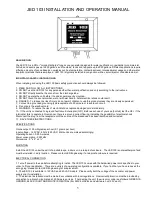
59
adjusting your driving behavior
of the cabling are used or to the brake boosters or diodes.
With the help of CV 134, the detection sensitivity can be influenced. Change the
value value (12) gradually and test until the result is OK.
10.4.4.3. ABC shuttle train
LokSound decoders allow 5 in conjunction with the ABC technique a simple,
centralized independent commuter trains. Here- to must ensure at each end of
the commute an ABC braking module for braking because the train. The module
must be respectively installed so that the locomotive is expected to reduce in a
direction to the left, with the other right direction (see FIG. Section 10.4.4). With
the help of CV 149, the Pendelzugautmatik can be activated if a stay> 0 seconds
is set. eg CV 149 = 20. Set will slow down the decoder upon detection of an
ABC-stopping stretch first, wait 20 seconds and then change direction. Since the
braking zone but is only active for one side of the track, the locomotive will then
sit down again on the move. At the other end of the commute in recognizing the
braking section is the whole "game" nen BEGIN again. CV 149 = 0 ends the
ABC commuter trains.
10.4.5. ZIMO HLU braking distance
By setting CV 27 bit 2 LokSound can five decoders also respond to Zimo's HLU
commands. The maximum speed in the desired areas can be indicated
accurately by means of the CVs 150-154.
10.4.6. Braking distance delay
Sometimes a bad rail contact can cause the brake signal is no longer recognized
correctly by the decoder. In this case, the decoder undesirably would accelerate
again. With the help of CV 102 a delay value can be specified. Only when the
decoder for the THE SET there te time finds no stopping stretch, the braking
mode will be left.
10.5. constant braking distance
An attractive feature is hidden behind the CV 254 (ESU braking mode): This
allows a constant path set advertising to which the train, from the beginning of
the brake sector to the stopping. This makes it possible, regardless of the rate-of
locomotive speed always to come to a halt just before the red signal. The
LokSound then calculates the required brake the locomotive.
The larger the value in CV 254, the longer the braking distance. Simply make
some appropriate for your Lok values from best on a test track.
If the value of CV 254 equal to 0, the time-dependent ge braking mode in accordance
with Section 10.1 is automatically activated. The constant braking distance is only active
in braking distances. If the knob is rotated manually to speed step 0, the braking time by
CV 4 is used.
With the help of CV253 can be selected as the LokSound decelerating.
Figure 35: Constant braking distance
A train) decelerates linearly: Immediately after entering the braking section
delaying linar until it comes to a stop.
Entry into the braking distance
Desired stopping point (defined
by CV 254)
Train B) is fast, just a short drives on until his
berechne-
th braking point, slows from to the
breakpoint.
Train C) also
continue to the calculated
braking point, decelerates
then constant up to the
stop point.
path
speed
Summary of Contents for 58315
Page 104: ...104 notes...
Page 105: ...105 notes...
Page 109: ...109 notes...
Page 110: ...110 notes...
Page 111: ...111...
















































